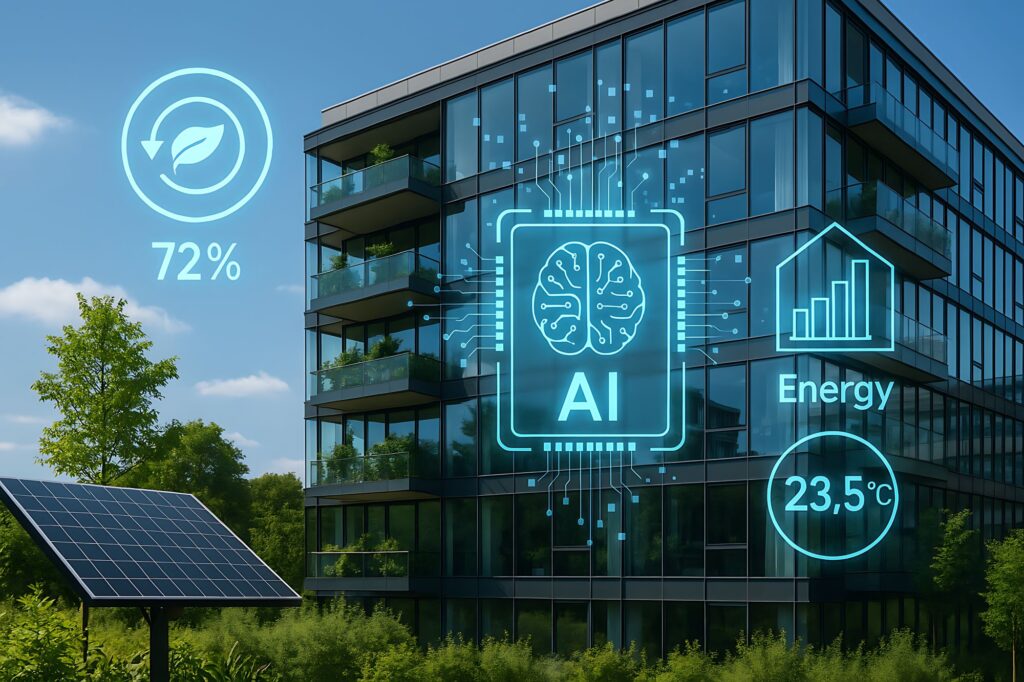In the last couple of years, barely a day has gone by without news around how the tech advances in artificial intelligence are going to change our lives. But how is it already being used in commercial real estate? And what further changes might it bring?
For most of its history, commercial real estate has thrived on relationships, spreadsheets and patience. Deals were built as much on gut instinct as on data. But the rise of artificial intelligence — particularly generative AI, the branch that synthesises text, images and insights — is beginning to shift the balance.
The change isn’t just hype. Across the industry, from the boardrooms of major developers to the mechanical rooms of office towers, AI is already working in practical ways. It is speeding up valuations, sharpening investment decisions, reducing energy use and even drafting tenant communications.
As CBRE noted in its recent research: “Artificial intelligence has moved beyond the theoretical stage in real estate. We are now at the point where the technology is being applied to core business processes, generating measurable outcomes, and fundamentally reshaping the way decisions are made.”
From pilots to practice
At first, AI in commercial real estate was little more than a curiosity. Firms launched pilots, tested algorithms, and experimented with automating pieces of their workflow. Now, adoption is accelerating.
JLL framed the moment in a recent report: “The discussion is no longer whether AI has a role in commercial real estate. The debate has shifted to whether this is a revolution that will transform the industry overnight, or an evolution that will unfold more gradually. Either way, the trajectory is clear: AI will become embedded in the operating model of most real estate companies.”
In underwriting, algorithms are digesting years of comparable sales, rental records and local economic indicators to generate valuations that once required days of work by analysts. In asset management, AI is running thousands of scenarios on entire portfolios, modelling the impact of interest rates, vacancies or policy changes in minutes rather than months.
And inside buildings themselves, AI-driven systems are learning the rhythms of occupants, fine-tuning heating and cooling to save energy while making spaces more comfortable.

As one CBRE analysis put it: “Predictive maintenance is no longer futuristic. By harnessing machine learning, building managers can now see weeks in advance when a system might fail, preventing tenant disruption and lowering costs.”
Efficiency and productivity
Many property professionals report that what eats up their time is repetitive research and reporting. Here, AI already shines. A market study that once took a team several days can now be distilled into a clear summary in minutes. Monthly reporting can be automated, with only exceptions escalated to human review.
As JLL explained, “The efficiency gains from AI are immediate and tangible. Companies are finding that by automating data collection and reporting, their people can devote more time to interpretation, client interaction and strategic planning — work that adds far more value than routine tasks ever could.”
Smarter decisions
Efficiency alone would be enough to justify the investment. But AI could also bring sharper, faster decision-making.
Imagine running thousands of ‘what if’ scenarios across a portfolio. What happens to cash flow if interest rates rise another point? What if a key tenant defaults? What if a planning change opens up redevelopment potential? AI can answer these questions in seconds, offering investors a probabilistic view of outcomes.
Generative AI in particular enhances decision-making by producing written recommendations, annotated visuals, and prioritised action lists. Instead of just raw data, executives receive insights packaged in a way that speeds understanding.
JLL, however, warns that success is not automatic. “Many companies are experimenting with AI pilots, but without a structured roadmap and governance framework, those efforts risk falling into the hype cycle,” the company said. “AI is not a plug-and-play solution — it requires clarity of purpose and disciplined execution to deliver results.”
New revenue and investment frontiers
If efficiency and better decisions are the obvious benefits, new revenue streams are the less discussed but equally powerful potential of AI.
One emerging opportunity is in asset repurposing. AI models can analyse underused office buildings, for example, and simulate scenarios for conversion into housing, lab space or logistics hubs. This kind of rapid modelling makes previously marginal opportunities worth serious consideration.
Another opportunity lies in data itself. Real estate companies that collect anonymised data on tenant behaviour and building performance are discovering that these datasets have value beyond internal use. Subscription products based on such data could become a new revenue stream, providing insights to occupiers, service providers, or ESG auditors.
Demand for AI-driven property technology is also rising. JLL put it simply: “We are seeing an explosion of interest in AI-enabled property technology, from startups that automate lease management to platforms that optimise energy use. This wave of innovation is not ancillary — it will define the next chapter of real estate services.”
Savills, in its global investment outlook, echoed that optimism: “Despite cyclical pressures, property investors can look forward to better times ahead. Structural drivers such as technological adoption, including the rise of artificial intelligence, will underpin recovery and create new avenues for growth.”
The generative AI difference

So, what is unique about generative AI? Unlike traditional models that only analyse numbers, generative AI can synthesise across text, images and even design concepts. That means an AI system can read through hundreds of pages of planning documents, summarise restrictions, generate a draft floor plan and produce marketing copy for a leasing brochure — all in one workflow.
As CBRE described it: “Generative AI goes beyond analysis. It creates outputs that are immediately usable in the real estate workflow — from a draft pitch deck to a conceptual layout. This changes the pace of work, compressing weeks of effort into hours.”
This versatility makes generative AI particularly attractive for front-office functions. Leasing teams can automate the production of tenant pitches. Marketing departments can generate tailored campaigns. Legal teams can draft clauses or summarise negotiation positions, leaving lawyers to focus on strategy and risk.
Risks and limits
The excitement around AI is palpable, but the risks are just as real. Data quality is one of the greatest challenges.
As CBRE cautioned, “Even the most advanced model cannot overcome poor inputs. If the data is incomplete, inaccurate, or biased, the outputs will be misleading. This is not a limitation of AI but a reflection of the industry’s responsibility to maintain robust data foundations.”
There is also the issue of explainability. Investment committees and regulators often demand to know why a decision was made. If an AI system cannot explain its reasoning, its outputs may be unusable, no matter how accurate.
As JLL emphasised, “Governance is critical. Without it, AI initiatives can quickly become expensive experiments that fail to scale. With it, AI can deliver consistent, auditable results that build confidence among clients, regulators and boards alike.”
Indeed, clearly not all companies are getting the value they expected. A recent MIT paper found that “despite $30–40 billion in enterprise investment into GenAI, this report uncovered a surprising result in that 95% of organisations are getting zero return”.
It adds: “The outcomes are so starkly divided across both buyers (enterprises, mid-market, SMBs) and builders (startups, vendors, consultancies) that we call it the GenAI Divide. Just 5% of integrated AI pilots are extracting millions in value, while the vast majority remain stuck with no measurable P&L [profit and loss] impact.”
Looking ahead
What might the next decade hold? Analysts sketch out three plausible scenarios. In the optimistic view, AI becomes mainstream, woven into underwriting, leasing, and operations. Transaction costs fall, productivity rises and new proptech markets flourish.
In a more selective future, only the firms with strong digital cultures and high-quality data reap the benefits, leaving laggards behind. In a more cautious world, regulatory concerns about privacy and liability slow adoption, particularly in areas like tenant profiling, forcing the industry to develop standards and certifications.
Whatever the trajectory, the consensus is clear: AI is not going away. It is becoming part of the infrastructure of real estate itself. This is not about machines taking over. It is about people and algorithms working together to make better decisions, faster. In CBRE’s words: “This is where AI becomes real.”
The use of AI in commercial real estate makes a lot of sense in theory, but how is it being used in practice?
Rightmove caught up with James Snowdon, CTO at Indurent, to find out.

What are the most effective uses you’ve found for AI so far?
At Indurent we built our own digital platform, Hive®, to give us a clear, real-time picture of every building and customer. Through Hive’s modern, integrated platforms, we can deploy AI solutions into our workflows at pace.
The biggest wins so far are in two areas, making operations smoother and improving the experience for our customers. AI now helps us speed up lease renewals, spot maintenance or energy issues early, interact with our customers more effectively, and produce environmental reports automatically.
It also powers our Smart Lease service, a simplified, all-inclusive contract written in plain English, designed to remove complexity and speed up the leasing journey for businesses occupying units under 5,000 sq ft. It allows smaller businesses to go from viewing a unit to moving in within days rather than weeks.
How easy have they been to implement?
Rolling out AI can be challenging if you’re stuck with older systems that can’t integrate modern solutions. We made it easier by investing early in modern cloud platforms, which gives us the flexibility to experiment and scale quickly. That foundation has allowed us to launch tools like our AI customer-service agent and environmental reporting tool within weeks.
What has been the reaction from your customers/clients/occupiers?
The response has been overwhelmingly positive and customers have embraced the change. In particular, they like having a faster onboarding process, clearer information and self-service portals instead of waiting for emails. Our teams also benefit because repetitive tasks are taken off their hands, freeing them to focus on creating value. Many small businesses view our Smart Lease as a “game-changer” because it removes the usual paperwork bottlenecks that slow down the take up of space. It also reduces leasing costs and gives occupiers more transparency over the costs they will incur occupying their space.
What sort of savings/efficiencies are you seeing/expect to see?
Over time, the savings we expect to see from the adoption of AI driven tools is very material. Tools like automated contract signing and streamlined financial reporting will save hundreds of thousands of pounds each annually and we see tens or even hundreds of individual use cases where this kind of technology can be deployed. One such area would be energy use and investment planning, which both supports our sustainability targets and strengthens the long-term value of the business.
Steve Pimblett, Chief Data Officer at Rightmove, on how the business is using AI

“Our data and AI strategy is about powering business growth by delivering value to our partners and consumers. We believe establishing an AI centre of excellence is critical to this.
We have dedicated tech and data AI teams, working with the majority of our business functions to experiment and create or enhance products and tools. Enabling access to the wider operational teams, we see as key to driving business innovation.
With that comes the need for process and governance so we can assess where AI can bring the most value for partners and consumers – and not just doing AI for the sake of it.
Right now, we’re working with Google as a key tech partner to utilise their AI solutions, plus we’re also building our own solutions. We run annual AI hackathons, bringing together tech teams to build new AI-driven software and we’re using AI internally to speed up everyday tasks and allow us to spend more time on innovation and delivering value to agents and consumers.
Having a really clear strategy is key to getting the best out of AI and with the scale of our data, it presents us with signficant advantages to make use of AI to create accurate models and even better experiences for our agents and consumers.
Sources:
CBRE — Where AI becomes real
CBRE — How AI Is Advancing Decision-Making in Corporate Real Estate
JLL — Artificial Intelligence: Real Estate Revolution or Evolution?
JLL — The future of AI in PropTech
Savills — 2025 Global Investment Outlook and Macro Themes
MIT — The GenAI Divide: State of AI in Business 2025
Copyright © 2000-2025 Rightmove Group Limited. All rights reserved. Rightmove prohibits the scraping of its content. You can find further details here.